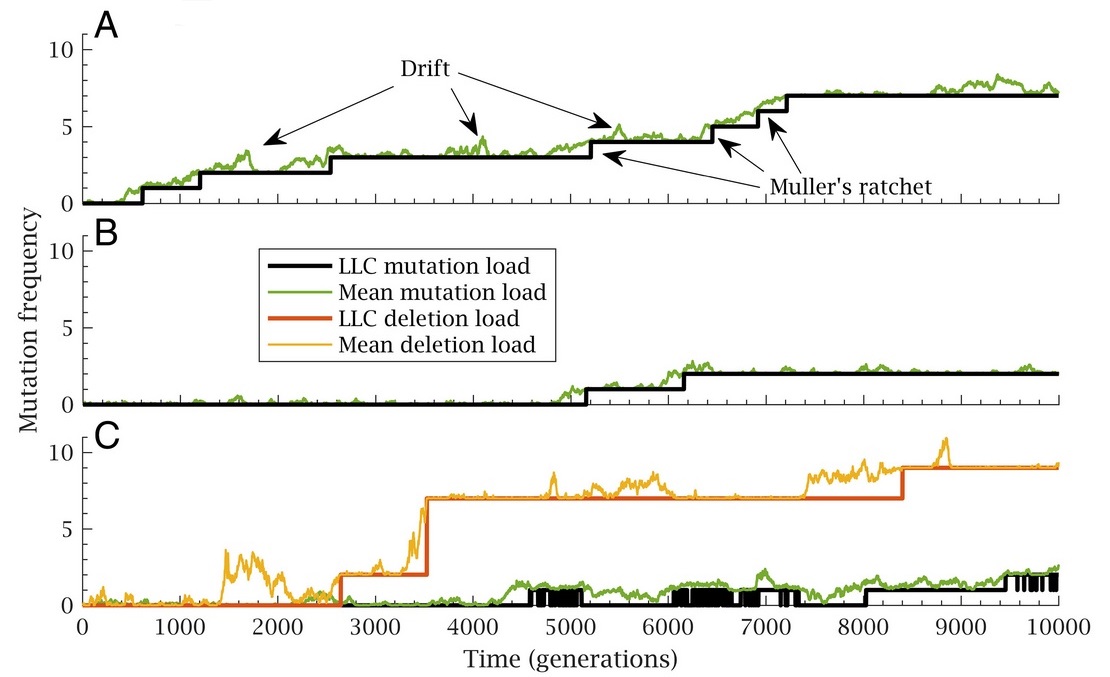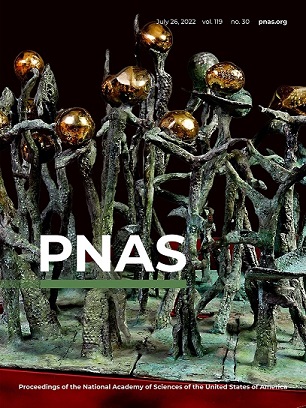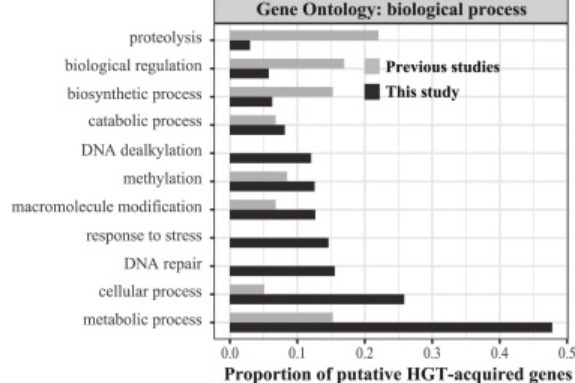What'sNEW Jul - Sep 2022
...we infer that -- at a time before the Earth itself had formed -- Mars was born wet.
 ...Mars' Early Atmosphere Suggest a Wet Planet Capable of Supporting Life, SETI Institute, 21 Sep 2022. ...Mars' Early Atmosphere Suggest a Wet Planet Capable of Supporting Life, SETI Institute, 21 Sep 2022.
 A primordial atmospheric origin of hydrospheric deuterium enrichment on Mars by Kaveh Pahlevan et al., Earth and Planetary Science Letters, 01 Oct 2022. A primordial atmospheric origin of hydrospheric deuterium enrichment on Mars by Kaveh Pahlevan et al., Earth and Planetary Science Letters, 01 Oct 2022.
 Life on Mars! has evidence from many sources for life there. Life on Mars! has evidence from many sources for life there.
Two bacterial enzymes are "remarkably similar" to human DNA repair enzymes. They are reverse transcriptases (RTs), one of which is encoded in an intron and can be knocked out without harm to the bacteria. Here we see further evidence for genetic programs with eukaryotic functions that are apparently acquired from simpler life, where they may even be silent. If so, the programs apparently lack darwinian provenence. There are countless other examples, most from viruses. A scientific theory in which that lack is not troubling, but is anticipated, would be better.
 "Group II intron-like reverse transcriptases function in double-strand break repair," by Seung Kuk Park et al., doi:10.1016/j.cell.2022.08.014, Cell, 15 Sep 2022. "Group II intron-like reverse transcriptases function in double-strand break repair," by Seung Kuk Park et al., doi:10.1016/j.cell.2022.08.014, Cell, 15 Sep 2022.
 Metazoan Genes Older Than Metazoa? has related examples. Metazoan Genes Older Than Metazoa? has related examples.
 Meiotic sex has benefits like purifying selection enhanced by gene conversion. How eukaryotes acquired it is the subject of a study by London geneticists using computer simulations. They ultimately comment, as traditional neo-darwinists often do, on the good fortune that permitted life on Earth to take its upward course.
Meiotic sex has benefits like purifying selection enhanced by gene conversion. How eukaryotes acquired it is the subject of a study by London geneticists using computer simulations. They ultimately comment, as traditional neo-darwinists often do, on the good fortune that permitted life on Earth to take its upward course.
The analysis is well worth studying, but I take a different lesson from it. I think it shows that evolution, with tinkering and puzzle-solving, deploys programming whose essence is already available in prokaryotic genomes:
"Prokaryotes possess homologs of the canonical molecular machinery for meiotic sex, including proteins of the SMC gene family of adenosine triphosphatases necessary for chromosome cohesion and condensation, as well as actin and tubulin, required for daughter cell separation and the movement of chromosomes. The Rad51/Dcm1 gene family, which plays a central role in meiosis, also has high protein sequence similarity with RecA, responsible for homologous search and recombination in prokaryotes. But why eukaryotes requisitioned this existing molecular machinery to evolve a completely new mechanism of reproduction, inheritance, and genetic exchange—meiotic sex—remains obscure."
 Repeat sequences limit the effectiveness of lateral gene transfer and favored the evolution of meiotic sex in early eukaryotes, by Marco Colnaghi et al., doi:10.1073/pnas.2205041119, PNAS, 22 Aug 2022. Repeat sequences limit the effectiveness of lateral gene transfer and favored the evolution of meiotic sex in early eukaryotes, by Marco Colnaghi et al., doi:10.1073/pnas.2205041119, PNAS, 22 Aug 2022.
 Metazoan Genes Older Than Metazoa? and Metazoan Genes Older Than Metazoa? and
 Genes Older Than Earth? have examples and discussion. Genes Older Than Earth? have examples and discussion.
 Why Sexual Reproduction? includes an introduction to Gene Conversion. Why Sexual Reproduction? includes an introduction to Gene Conversion.
...Mars is this watery, habitable place, and all the samples we're getting back are going to help us understand the history of ancient microbial life on Mars.
 Compositionally and density stratified igneous terrain in Jezero crater, Mars, by Roger C. Wiens et al. Science Advances, 25 Aug 2022. Compositionally and density stratified igneous terrain in Jezero crater, Mars, by Roger C. Wiens et al. Science Advances, 25 Aug 2022.
 Aqueously altered igneous rocks sampled on the floor of Jezero crater, Mars, by Kenneth Farley et al. Science, 25 Aug 2022. Aqueously altered igneous rocks sampled on the floor of Jezero crater, Mars, by Kenneth Farley et al. Science, 25 Aug 2022.
 The sands of Mars are green as well as red, rover Perseverance discovers, Purdue University, 25 Aug 2022. The sands of Mars are green as well as red, rover Perseverance discovers, Purdue University, 25 Aug 2022.
 Life on Mars! has more. Life on Mars! has more.
...animals arose only after the accumulation of genes functionally important for their multicellularity, a tendency that began in the pre-metazoan ancestors and later accelerated in the metazoan root. The genes "accumulate" with no hint of any "origin," neo-darwinian or otherwise. They seem to simply come from the past. Naturally, some are also discarded along the way.
 "Divergent genomic trajectories predate the origin of animals and fungi" by Ocaña-Pallarès, E., Williams, T.A., López-Escardó, D. et al., doi:10.1038/s41586-022-05110-4, Nature, 24 Aug 2022. "Divergent genomic trajectories predate the origin of animals and fungi" by Ocaña-Pallarès, E., Williams, T.A., López-Escardó, D. et al., doi:10.1038/s41586-022-05110-4, Nature, 24 Aug 2022.
 Metazoan Genes Older Than Metazoa? and Metazoan Genes Older Than Metazoa? and
 Genes Older Than Earth? have more examples of genes with no hint of any origin, neo-darwinian or otherwise. Genes Older Than Earth? have more examples of genes with no hint of any origin, neo-darwinian or otherwise.
 James A. Shapiro is a biochemist and molecular biologist at the University of Chicago and an eminent authority on the theory of evolution. He noticed the shortcomings of Neo-Darwinism and the importance of HGT at least 25 years ago. In 2011, he published the first edition of Evolution: A View from the 21st Century, listing many genetic phenomena whose role was little appreciated theretofore. In brief, the genome is not just a Read-Only-Memory, but a Read-Write system capable of Natural Genetic Engineering (NGE). This would include the installing, testing, puzzle-solving, optimizing, etc. that cosmic ancestry requires. Shapiro is also a founder of "The Third Way: evolution in the era of genomics and epigenomics," an international collection of various renegade experts.
James A. Shapiro is a biochemist and molecular biologist at the University of Chicago and an eminent authority on the theory of evolution. He noticed the shortcomings of Neo-Darwinism and the importance of HGT at least 25 years ago. In 2011, he published the first edition of Evolution: A View from the 21st Century, listing many genetic phenomena whose role was little appreciated theretofore. In brief, the genome is not just a Read-Only-Memory, but a Read-Write system capable of Natural Genetic Engineering (NGE). This would include the installing, testing, puzzle-solving, optimizing, etc. that cosmic ancestry requires. Shapiro is also a founder of "The Third Way: evolution in the era of genomics and epigenomics," an international collection of various renegade experts.
With my own renegade view, I asked him to send me a recent paper of his. This led to a summer-long discussion of our agreements and differences. He believes that NGE can not only manage available programs, but even invent new genetic programming. I believe the invention part is undemonstrated. If it were demonstrated, the mainstream theory of evolution - including Shapiro's version - would get powerful confirmation. Until then, I believe, a system in which the programming is already available should not be overlooked. This thinking is too radical even for the Third Way, it turns out. Shapiro and I did not reach consensus. Still, the conversation might be useful to historians-of-science, because two very different paradigms were, for a time, listening to each other. When evolution is the subject, that seldom happens.
 Correspondence with James Shapiro, Jun-Aug 2022 Correspondence with James Shapiro, Jun-Aug 2022
 30 Dec 2012: our review of Evolution: A View from the 21st Century. 30 Dec 2012: our review of Evolution: A View from the 21st Century.
 09 Dec 2012: more about Shapiro. 09 Dec 2012: more about Shapiro.
...hundreds, maybe even 1000 times more bright galaxies in the early universe than astronomers anticipated have been seen with the James Webb Telescope. Further observations will reveal more, but astronomers are already (again) wondering if the standard model of cosmology needs a complete overhaul. For cosmic ancestry this is a welcome development, because a super-hot big bang, everywhere-at-once, would sterilize the universe.
 "Webb telescope reveals unpredicted bounty of bright galaxies in early universe" by Daniel Clery, Science, 09 Aug 2022. "Webb telescope reveals unpredicted bounty of bright galaxies in early universe" by Daniel Clery, Science, 09 Aug 2022.
 The End... cites issues for the standard big bang. The End... cites issues for the standard big bang.
 James Ephraim Lovelock died, 26 July 2022. He is best known for Gaia, his theory that life engineers the environment to make it suitable for life. His early work also helped the world become aware of environmental dangers like global warming and the Antarctic ozone hole. In his latest years, the environment became his preoccupation, as seems appropriate.
James Ephraim Lovelock died, 26 July 2022. He is best known for Gaia, his theory that life engineers the environment to make it suitable for life. His early work also helped the world become aware of environmental dangers like global warming and the Antarctic ozone hole. In his latest years, the environment became his preoccupation, as seems appropriate.
He also influenced my thinking, because if life is to evolve by cosmic ancestry, Gaia's environmental engineering is essential. Cyanobacteria must make oxygen, all the exposed iron must rust before oxygen can accumulate, ozone (and methane?) must shield out harmful radiation, carbon must be buried, etc. But he deserves to be known by everyone.
 "James Lovelock (1919–2022): Father of Earth system science," by Timothy M. Lenton, Science, 25 Aug 2022. "James Lovelock (1919–2022): Father of Earth system science," by Timothy M. Lenton, Science, 25 Aug 2022.
 "James E. Lovelock (1919–2022)," by John Gribbin, Nature, 03 Aug 2022. "James E. Lovelock (1919–2022)," by John Gribbin, Nature, 03 Aug 2022.
 "James Lovelock, Whose Gaia Theory Saw the Earth as Alive...," by Keith Schneider, The New York Times, 27 Jul 2022. ...the maverick British ecologist whose work was essential to today's understanding of man-made pollutants and their effect on climate and who captured the scientific world's imagination with his Gaia theory, portraying the Earth as a living creature, died on Tuesday, his 103rd birthday, at his home in Dorset, in southwest England. "James Lovelock, Whose Gaia Theory Saw the Earth as Alive...," by Keith Schneider, The New York Times, 27 Jul 2022. ...the maverick British ecologist whose work was essential to today's understanding of man-made pollutants and their effect on climate and who captured the scientific world's imagination with his Gaia theory, portraying the Earth as a living creature, died on Tuesday, his 103rd birthday, at his home in Dorset, in southwest England.
 Thanks for a first alert, Chris Lodewyks and Craig Hutchison. Thanks for a first alert, Chris Lodewyks and Craig Hutchison.
 Gaia has more, with links and updates about Lovelock. Gaia has more, with links and updates about Lovelock.
 Technical advances have brought an accelerating flood of data, most recently, giving us complete genome sequences and expression patterns from any species. Yet, arguably, no fundamentally new principles have been established in molecular biology, and, in evolutionary biology, despite sophisticated theoretical advances and abundant data, we still grapple with the same questions as a century or more ago.
Technical advances have brought an accelerating flood of data, most recently, giving us complete genome sequences and expression patterns from any species. Yet, arguably, no fundamentally new principles have been established in molecular biology, and, in evolutionary biology, despite sophisticated theoretical advances and abundant data, we still grapple with the same questions as a century or more ago.
So comments evolutionary biologist Nicholas Barton in the latest issue of PNAS. His article is among nine in an open-access feature about the Austrian monk Gregor Mendel. Born 200 years ago, Mendel did pioneering analysis of trait inheritance among plants, but his work went little-known for forty years. Yet his insights were fruitful and remain valid. He is certainly not to blame if today's theory of evolution is completely stalled. It is disabled by a wrong basic assumption about the mechanism behind genetic advances, which Mendel never studied.
Evolutionists, including some of these PNAS authors, understand that prokaryotes depend on a huge pangenome for macroevolution, but no one notices the magnitude of that paradigm shift. Nor do they notice that eukaryotes might likewise have access to an enormous pool of genetic potential.
 Gregor Johann Mendel and the development of modern evolutionary biology by Nils Chr. Stenseth et al., doi:10.1073/pnas.2201327119, PNAS, 26 Jul 2022. Gregor Johann Mendel and the development of modern evolutionary biology by Nils Chr. Stenseth et al., doi:10.1073/pnas.2201327119, PNAS, 26 Jul 2022.
 The "New Synthesis" by Nicholas H. Barton, doi:10.1073/pnas.2122147119, PNAS, 26 Jul 2022. The "New Synthesis" by Nicholas H. Barton, doi:10.1073/pnas.2122147119, PNAS, 26 Jul 2022.
 Genetics of adaptation by Kirsten Bomblies and Catherine L. Peichel, doi:10.1073/pnas.2122152119, PNAS, 26 Jul 2022. Genetics of adaptation by Kirsten Bomblies and Catherine L. Peichel, doi:10.1073/pnas.2122152119, PNAS, 26 Jul 2022.
 Mendel and Darwin by Andrew Berrya and Janet Browne, doi:10.1073/pnas.2122144119, PNAS, 26 Jul 2022. Mendel and Darwin by Andrew Berrya and Janet Browne, doi:10.1073/pnas.2122144119, PNAS, 26 Jul 2022.
 Neo-Darwinism: The Current Paradigm has comments on today's theory of evolution. Neo-Darwinism: The Current Paradigm has comments on today's theory of evolution.
Synthetic genomics is making rapid progress, as a detailed open-access review confirms. Craig Venter et al. see benefits for medicine, agriculture and related fields. Some benefits have already been reached, like mRNA vaccines. Others will be more difficult to achieve; some are futuristic with unknown implications. The review is comprehensive and informative. Recommended.
 "Synthetic chromosomes, genomes, viruses, and cells
" by J. Craig Venter et al., doi:10.1016/j.cell.2022.06.046, Cell, 21 Jul 2022. "Synthetic chromosomes, genomes, viruses, and cells
" by J. Craig Venter et al., doi:10.1016/j.cell.2022.06.046, Cell, 21 Jul 2022.
 31 May 2010 and 31 May 2010 and
 26 Mar 2016: More about Venter et al. and synthetic cells.
The article says nothing directly about evolution, but I still found it revealing. First, a genomically engineered new sequence may be correct, but getting it to function is always difficult, because so many things can go wrong — especially in eukaryotic life. In nature, how would letting darwinian life simply take its course make those things go right? Besides, in nature, chancing upon a new functional sequence of only 100 nucleotides is astronomically unlikely to begin with. Better if the "new" sequence exists already, is delivered by HGT, and appropriate genomic software handles the implementation. Testing and optimization would still be subject to neo-darwinian selection. And even with cosmic ancestry, evolution is still time-consuming and dicey. 26 Mar 2016: More about Venter et al. and synthetic cells.
The article says nothing directly about evolution, but I still found it revealing. First, a genomically engineered new sequence may be correct, but getting it to function is always difficult, because so many things can go wrong — especially in eukaryotic life. In nature, how would letting darwinian life simply take its course make those things go right? Besides, in nature, chancing upon a new functional sequence of only 100 nucleotides is astronomically unlikely to begin with. Better if the "new" sequence exists already, is delivered by HGT, and appropriate genomic software handles the implementation. Testing and optimization would still be subject to neo-darwinian selection. And even with cosmic ancestry, evolution is still time-consuming and dicey.
 The Logical End includes related, futuristic speculation of 25 years ago. The Logical End includes related, futuristic speculation of 25 years ago.
| 18 Jul 2022 |
What'sNEW about HGT
 | |
|
 We systematically examined HGT in 218 high-quality genomes of diverse insects and found that they acquired 1,410 genes exhibiting diverse functions ...via 741 distinct transfers from non-metazoan donors. ...We conclude that HGT has been a major contributor to insect adaptation.
We systematically examined HGT in 218 high-quality genomes of diverse insects and found that they acquired 1,410 genes exhibiting diverse functions ...via 741 distinct transfers from non-metazoan donors. ...We conclude that HGT has been a major contributor to insect adaptation.
 "HGT is widespread in insects and contributes to male courtship in lepidopterans" by Yang Li et al., doi:10.1016/j.cell.2022.06.014, Cell, 18 Jul 2022, (bar graph, right). "HGT is widespread in insects and contributes to male courtship in lepidopterans" by Yang Li et al., doi:10.1016/j.cell.2022.06.014, Cell, 18 Jul 2022, (bar graph, right).
 "Insects harbor over a thousand genes from microbes, which help them survive", ScienceDaily, 18 Jul 2022. "Insects harbor over a thousand genes from microbes, which help them survive", ScienceDaily, 18 Jul 2022.
Also ...two major episodes of historical HGT events have significantly shaped the long-term evolution of land plants. ...our data point to a far greater scope of historical HGT than we currently realize.

 "Major episodes of horizontal gene transfer drove the evolution of land plants" by Jianchao Ma, Shuanghua Wang et al., doi:10.1016/j.molp.2022.02.001 (open access), Moleculer Plant, 02 May 2022 (flowchart example, left). "Major episodes of horizontal gene transfer drove the evolution of land plants" by Jianchao Ma, Shuanghua Wang et al., doi:10.1016/j.molp.2022.02.001 (open access), Moleculer Plant, 02 May 2022 (flowchart example, left).
 "Bacteria genes gave ancient plants traits to colonize land", ScienceDaily, 01 Mar 2022.
Horizontal gene transfer provides the programming behind ongoing macroevolutionary advances, according to cosmic ancestry. For prokaryotes, the case is closed, but the evidence is overwhelming for all kingdoms. It's time to recognize a simpler, clearer way for life to find new genes. "Bacteria genes gave ancient plants traits to colonize land", ScienceDaily, 01 Mar 2022.
Horizontal gene transfer provides the programming behind ongoing macroevolutionary advances, according to cosmic ancestry. For prokaryotes, the case is closed, but the evidence is overwhelming for all kingdoms. It's time to recognize a simpler, clearer way for life to find new genes.
 "Horizontal Gene Transfer Happens More Often Than Anyone Thought," by Christie Wilcox, The Scientist, 05 Jul 2022. "Horizontal Gene Transfer Happens More Often Than Anyone Thought," by Christie Wilcox, The Scientist, 05 Jul 2022.
 Viruses... cites more than 2,000 examples of HGT, crossing all kingdoms. Viruses... cites more than 2,000 examples of HGT, crossing all kingdoms.
 10 Mar 2021: summary evidence for prokaryotes. 10 Mar 2021: summary evidence for prokaryotes.
...DNA is not only moving around the tree of life, but it's moving a lot more frequently than anyone had imagined, and the cases of HGT that have been identified are just a small sample of the total transfers that have taken place over evolutionary time. And most transfers are not retained, according to evolutionary genomicist Antonis Rokas. He is among HGT experts consulted in an open-eyed popular review.

 "Horizontal Gene Transfer Happens More Often Than Anyone Thought" by Christie Wilcox, The Scientist, 05 Jul 2022. "Horizontal Gene Transfer Happens More Often Than Anyone Thought" by Christie Wilcox, The Scientist, 05 Jul 2022.
 Viruses and Other Gene Transfer Mechanisms cites has many examples. Viruses and Other Gene Transfer Mechanisms cites has many examples.
What we think we know limits our ability to know even more — Ed Yong
 on the wondrous world of animal senses, Nature Podcast, 01 Jul 2022. on the wondrous world of animal senses, Nature Podcast, 01 Jul 2022.
 Thanks, Bob Rock, for mentioning this neglected topic. Thanks, Bob Rock, for mentioning this neglected topic.
![]()
|

 James A. Shapiro is a biochemist and molecular biologist at the University of Chicago and an eminent authority on the theory of evolution. He noticed the shortcomings of Neo-Darwinism and the importance of HGT at least 25 years ago. In 2011, he published the first edition of Evolution: A View from the 21st Century, listing many genetic phenomena whose role was little appreciated theretofore. In brief, the genome is not just a Read-Only-Memory, but a Read-Write system capable of Natural Genetic Engineering (NGE). This would include the installing, testing, puzzle-solving, optimizing, etc. that cosmic ancestry requires. Shapiro is also a founder of "The Third Way: evolution in the era of genomics and epigenomics," an international collection of various renegade experts.
James A. Shapiro is a biochemist and molecular biologist at the University of Chicago and an eminent authority on the theory of evolution. He noticed the shortcomings of Neo-Darwinism and the importance of HGT at least 25 years ago. In 2011, he published the first edition of Evolution: A View from the 21st Century, listing many genetic phenomena whose role was little appreciated theretofore. In brief, the genome is not just a Read-Only-Memory, but a Read-Write system capable of Natural Genetic Engineering (NGE). This would include the installing, testing, puzzle-solving, optimizing, etc. that cosmic ancestry requires. Shapiro is also a founder of "The Third Way: evolution in the era of genomics and epigenomics," an international collection of various renegade experts.
 James Ephraim Lovelock died, 26 July 2022. He is best known for Gaia, his theory that life engineers the environment to make it suitable for life. His early work also helped the world become aware of environmental dangers like global warming and the Antarctic ozone hole. In his latest years, the environment became his preoccupation, as seems appropriate.
James Ephraim Lovelock died, 26 July 2022. He is best known for Gaia, his theory that life engineers the environment to make it suitable for life. His early work also helped the world become aware of environmental dangers like global warming and the Antarctic ozone hole. In his latest years, the environment became his preoccupation, as seems appropriate.
 Technical advances have brought an accelerating flood of data, most recently, giving us complete genome sequences and expression patterns from any species. Yet, arguably, no fundamentally new principles have been established in molecular biology, and, in evolutionary biology, despite sophisticated theoretical advances and abundant data, we still grapple with the same questions as a century or more ago.
Technical advances have brought an accelerating flood of data, most recently, giving us complete genome sequences and expression patterns from any species. Yet, arguably, no fundamentally new principles have been established in molecular biology, and, in evolutionary biology, despite sophisticated theoretical advances and abundant data, we still grapple with the same questions as a century or more ago.
 We systematically examined HGT in 218 high-quality genomes of diverse insects and found that they acquired 1,410 genes exhibiting diverse functions ...via 741 distinct transfers from non-metazoan donors. ...We conclude that HGT has been a major contributor to insect adaptation.
We systematically examined HGT in 218 high-quality genomes of diverse insects and found that they acquired 1,410 genes exhibiting diverse functions ...via 741 distinct transfers from non-metazoan donors. ...We conclude that HGT has been a major contributor to insect adaptation.

